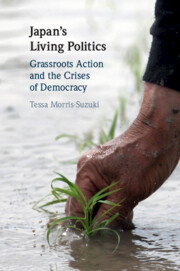Book contents
- Japan’s Living Politics
- Japan’s Living Politics
- Copyright page
- Contents
- Maps
- Figures
- Acknowledgements
- Maps
- 1 Japan and the Crisis of Democracy
- 2 Living Politics
- 3 The White Birch and the Earth
- 4 Rethinking the Village
- 5 Peasant Art, Free Drawing and the Free University
- 6 The Body Politic
- 7 Seeds of Democracy
- 8 Development from Within
- 9 Disaster and Aftermath
- 10 Conclusions and Beginnings
- Bibliography
- Index
3 - The White Birch and the Earth
Giving Life to the Self in Interwar Japan and Beyond
Published online by Cambridge University Press: 16 April 2020
- Japan’s Living Politics
- Japan’s Living Politics
- Copyright page
- Contents
- Maps
- Figures
- Acknowledgements
- Maps
- 1 Japan and the Crisis of Democracy
- 2 Living Politics
- 3 The White Birch and the Earth
- 4 Rethinking the Village
- 5 Peasant Art, Free Drawing and the Free University
- 6 The Body Politic
- 7 Seeds of Democracy
- 8 Development from Within
- 9 Disaster and Aftermath
- 10 Conclusions and Beginnings
- Bibliography
- Index
Summary
This chapter explores the activities of a group of young rural teachers who, in the 1910s and 1920s, sought to develop a radically alternative form of lifelong education as a basis for transforming and ‘humanizing’ industrializing Japan. Their chief source of inspiration was the White Birch (Shirakaba) movement, named after the journal Shirakaba, founded in 1910. The White Birch movement’s founders were members of Japan’s social elite, and the movement is often seen as an intellectual coterie removed from the social realities of early twentieth century Japan. I argue, though, that the schoolteachers who took up and tried to practice the group’s ideas had a much greater connection to everyday social problems. The chapter discusses events such as the Togura Incident of 1918, in which actions by White Birch Teachers led to clashes with the authorities, and goes on to highlight the direct and indirect links which were formed between the White Birch activists and like-minded communities overseas, including the Dartington Hall group in Britain and, in India, Rabidranath Tagore’s agrarian and educational communities and the Andretta craft community.
- Type
- Chapter
- Information
- Japan's Living PoliticsGrassroots Action and the Crises of Democracy, pp. 37 - 69Publisher: Cambridge University PressPrint publication year: 2020

